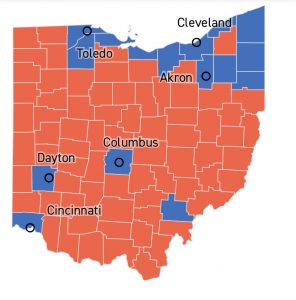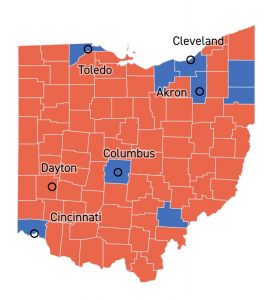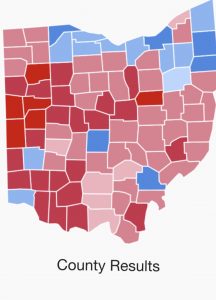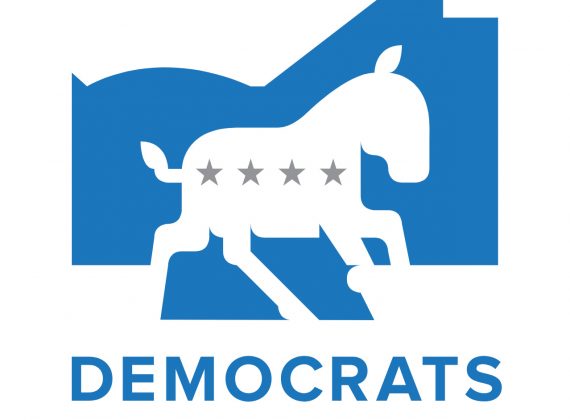
Democratic Senator Sherrod Brown’s recent, albeit relatively close, re-election to the U.S. Senate has caused a bit of talk here in Ohio and around the country about his prospects for the party’s nomination in 2020. The punditry and prognosticators have been taking note as well with the New York Times writing about him last week and POLITICO interviewing him this week. References to his rumpled style and raspy voice might make us Ohioans who’ve known him for decades roll our eyes, but the fact they’re talking about it means Brown has a seat at the very large table.
Brown himself has been floating serious trial balloons, while employing some inarguable talking points about the current president’s divisivenes. Brown asserts that his brand of populism is one free from divisions along color, gender, geographical, and sexual orientation lines. To standout from the dozens of other potential candidates, Brown will have to promote his culturally liberal bona fides (which a man who’s been on the right side of gay marriage since the 1990s should presumably be able to do). Attacking him as a lifelong politician might not hurt him in the primaries, but could be a problem against Trump and his acolytes in a general election. However, it’ll also be intriguing to see what tactics they’d employ against a white male who hasn’t been consistently vilified for a quarter century like Trump’s 2016 opponent was.
As I’d mentioned in the past, if Brown had won the state by double digits, national Democrats simply could not overlook him. His vicctory by nearly 6.5 points–though not overwhelming–should still serve as a wakeup call and Brown is arguing that his roadmap to re-election is a template for the national party. And his ability to make a class-based argument that transcends racial divsions, just might have staying power. To clearly show what Brown speaks of we can look at the map of Brown’s win vs. that of defeated Democratic gubernatorial candidate Richard Cordray:


Brown won seven more counties than Crodray and it’ll be those counties a Democrat must win if Ohio is to go blue in 2020. Indeed, Brown’s road to victory (left) mirrors President Obama’s 2012 Ohio win (right) , with the exception of Stark and Sandusky counties for Obama in ’12 and Brown winning Lake County this year.


Though far from definitive proof that he’ll be the next person in the White House, these maps show that Sherrod Brown knows the path to victory in the our state. For Democrats to carry Ohio in two years it might well be necessary for Brown to be somewhere on the ticket. And he’d probably have to be at the top. But, it’s even more accurate to say that any election in which Republicans are playing defense in the Buckeye state will surely spell a disaster for them in 2020.
While I shan’t get into any predictions about who the nominee(s) will be 17 months from now, I’m of a mindset when it comes to the party’s nominee for ’20, that there are (at least) three primary categories from which they will be chosen. This isna’t a comprehensive listing of potential candidates, since I don’t have 30 days to sit at my computer, and Categories 1 and 2 have some overlap, but these are the groupings as i see it now.
1.) Cult of personality
- Beto O’Rourke- He’s been called the “white Obama” and what he did in Texas was amost beyond belief. His doggedness, unabashed liberalism (especially in a state where that term is anathema), youth, and fundraising ability means he can effortlessly inspire a following that could bring aboard a who’s-who of pop culture and political standing.
- Bernie Sanders- He still has many, many dedicated followers. Probably not as many who were willing to go to the mattresses for him in 2016, but enough diehards who still believe he would’ve beaten Trump (possible) and even some who turned their zest for Bernie into outright antipathy for Hillary and helped prevent her election. The fact that he’ll be 79 years old in 2020 might give some pause.
- Elizabeth Warren- She too has a national following. Though like Sanders it may not be as wide or deep as it was two or three years ago, she will be able to rely upon her progressive bona fides to make a national campaign more than legitimate. Unfortunately, the Trump campaign won’t have to dust off any old playbooks on how to sow divisions against an older white woman.
- Julian Castro-The former San Antonio mayor, HUD Secretary, and Harvard Law graduate is certainly more than the sum of his ethnic background parts, but being the first Latino nominee and in his forties could potentially serve as a launching pad to success.
2.) Progressives
Or what Trumpians would call socialists, since they label anyone who defends those who aren’t ashamed to make less than $100K per year by that moniker. Alexandria Ocasio-Cortez would be the front-runner in this category but the Constitution will prevent someone her age from running (even if it doesn’t prevent Canadian-born Texans of Cuban descent from doing so).
- Sen. Kamala Harris (CA)- Her biography and familial background is almost Obama-esque in its nature. Hailing from California would enable the to paint her as some sort of coastal communist, but this is hardly her fault.
- Sen. Cory Booker (NJ)- He’s become more liberal as a senator than he was previously and he might be the most gifted speaker of those listed herein. Whether he’s considered a master of reading the tea leaves or just a typical politician reamins to be seen.
3.) Blue-collar/Midwesterners
- Brown
- Joe Biden- The former Veep has undenialbe cache and name recognition. He’s long burnished his blue-collar bona fides and those who think the party needs a white male to save them, would turn to him first. One wonders about his propensity for gaffes and possibly, like Sanders, his age. Also, there is probably a reason why he’s run for president twice before without receiving a single delegate.
- Sen. Amy Klobuchar (MN)- Her overwhelming victory in a state that’s been inexorably moving toward the Republicans was eye-popping. Garnering 60% of the vote, she beat her opponent by 24 points in a state Trump lost in 2016 by only 1.5 points. Like Brown’s victory in a state where Trump won, Klobuchar has credence at the very least for her electoral success in a swing state.
As much as a Brown-O’Rourke ticket would make my liberal, Ohio heart flutter, it may not be the best optics for the party to have two white males on their national ticket. But, in a wide open primary field, the question we can best ask about Sherrod Brown is: why not?




